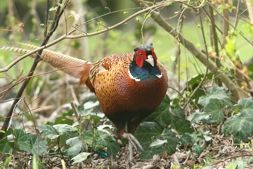
One of the best things about “eating the seasons” is that there’s never time to get bored. As one food falls off the seasonal calendar, another takes its place. So it’s goodbye to the vibrant flavours of summer and hello to richer autumn treats, such as one of my favourite game birds - pheasant. This article was prompted by a call from my friend (and Local Food Surrey member) Stephen Prince of Prince and Sons Family Butchers near Woking to tell me they will have pheasants in from October 1. Stephen and the lads are game experts, so do give them a call or drop by if you fancy a change from chicken. Visit Prince and Sons family butcher page by following this link.
Hatched in spring, pheasant chicks are generally raised in enclosed pens that allow them plenty of room to roam and forage but which protect them from predators. They are released in summer to mature ready for the shooting season, which starts on October 1.
By now, the birds are still young and tender but filling out nicely and although sizes vary, a brace (usually one cock and one hen) should provide a hearty meal for four. Fresh birds continue to be available until the season ends on January 31, so pheasant is the perfect dish for the festive season.
Don’t be put off by stories of game birds left hanging until they are green and crawling with maggots, or until their feet fall off. In days gone by, it was traditional to hang pheasants for as long as possible, thus developing the “gamey” flavour. It really is a matter of choice. Ask your butcher’s opinion on hanging when you order your bird, but in my view, two days is about right, or a little longer for a fuller flavour.
If you are buying just one pheasant, bear in mind that cocks are generally bigger than hens, although I sometimes find them a little dryer. In January, there may be more cocks available because gamekeepers hold cock shoots to reduce the number of male birds as the season ends, as only around eight are needed per enclosure of brood hens. To get some idea of the age of a cock bird, look at the feet spurs – the bigger they are, the older the bird. I have nothing against an old bird, but cook slowly in a pot to tenderise the meat – try adding red wine, port or dry sherry and some root vegetables for a deliciously rich and tasty sauce.
If you are open roasting your pheasant, which is a perfectly good way to prepare the younger birds you will buy at the beginning of the season, allow a cooking time of 45 minutes to an hour, depending on size. Pheasants are quite small, and easily dry out. Before roasting, try popping half an apple or lemon inside, which will help to keep it moist. A peeled onion will also work well. Rub some butter or oil over the bird and lay rashers of streaky bacon over the breast. Baste regularly. Or you could mix some butter with the seasoning of your choice (lemon zest, fresh chopped thyme and black pepper is nice) and smear it under the skin.
One word of warning – do look out for the lead shot which is often still inside game birds and can’t be removed before cooking. Just take your time and savour every mouthful. After all, good food shouldn’t be hurried.
Buy game in Surrey - follow this link to find your nearest game meat supplier
Tags: Pheasant
Game

